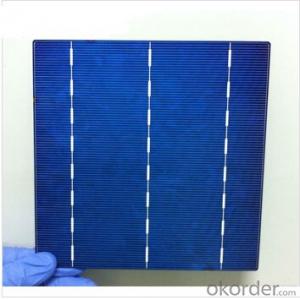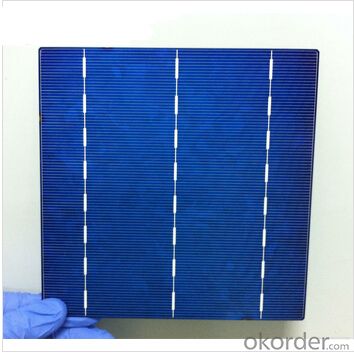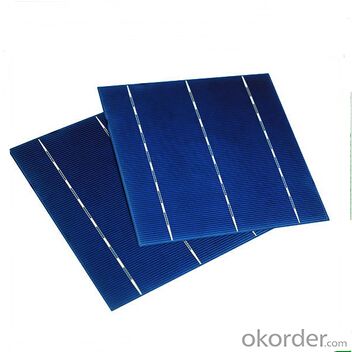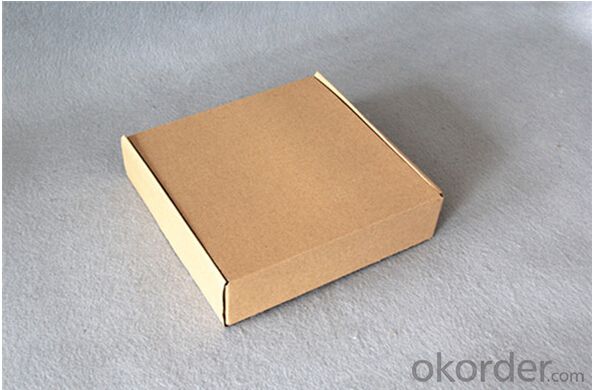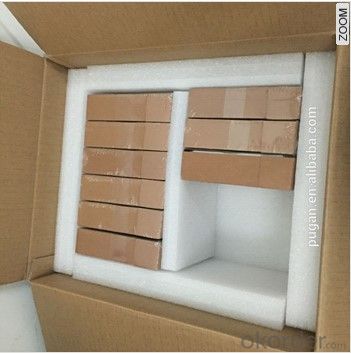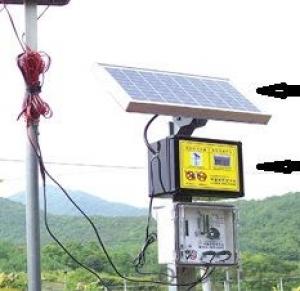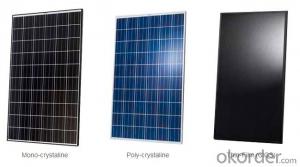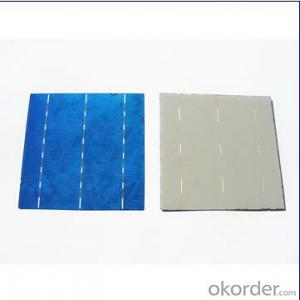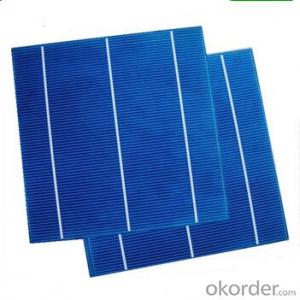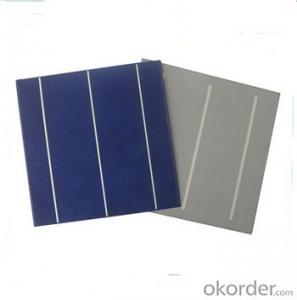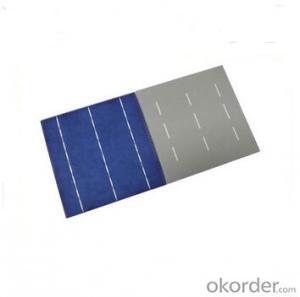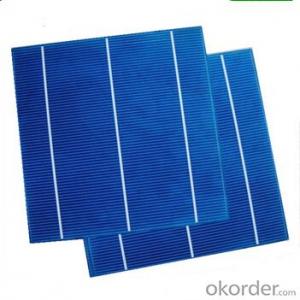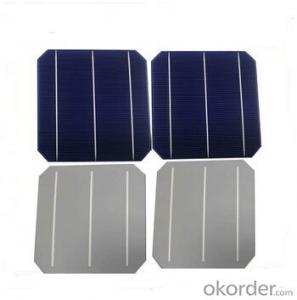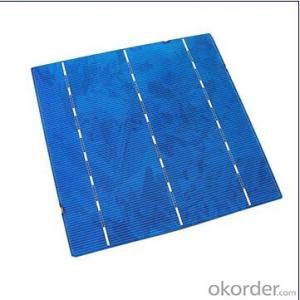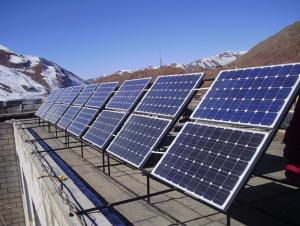Multi Junction Polycrystalline Solar Cells Series- 16.00-17.99%
- Loading Port:
- Shanghai
- Payment Terms:
- TT OR LC
- Min Order Qty:
- 3000 pc
- Supply Capability:
- 300000 pc/month
OKorder Service Pledge
OKorder Financial Service
You Might Also Like
Solar Cells:
Solar cells is made by solar wafer, it has three categories of solar cell right now, monocrystalline polycrystalline and thin film,These cells are entirely based around the concept PN junction, which is the critical part of solar module, it is the part that can convert the light energy into electricity, the thickness is from 180um to 200um, with even busbars to conduct electricity, textured cell can decrease diffuse reflection; they are often electrically connected and encapsulated as a module. Photovoltaic modules often have a sheet of glass on the front (sun up) side, allowing light to pass while protecting semiconductor wafers from abrasion and impact due to wind-driven debris, rain, hail, etc. Solar cells are also usually connected in series in modules, creating an additive voltage. Connecting cells in parallel will yield a higher current;With high quality and stable quality. Our Cells can greatly improve the performance of Solar Modules.
Features:
1. High conversion efficiencies resulting in superior power output performance.
2. Proven long term mechanical stability of silicon
3. Make of highly purified poly silicon
4. Three bus bars for reduced series resistance and improved module and cell efficiency
5. Blue anti-reflecting coating ensures improved light absorption and increased efficiency
6. Acid texturization offers a uniform appearance and virtually invisible crystal structure
7. Excellent low light behavior for improved energy yield
Solar Cells Advantage:
1. Tire-1 Solar Cells’ Manufacturer Quality Guarantee. With a complete and sophisticated quality government system, our Quality Management have arrived world’s leading place. Customer can receive Tire-1 Cells Maker’s Quality Standard Products.
2. Trusted Warranty. We can supply trusted after-sales service to our customer. If our cells are found not in conformity to the specification of manufacturer, or should the inspected quantity found in shortage, or should the packing found damaged, the buyer has the right to claim to the seller. The claim, if any, should be presented to seller within 30 days after cargo's arrival date to the port, together with related inspection report and photos issued and provided by a reputable independent surveyor such as SGS.
3. World’s Leading Manufacturer Equipment. We imported the newest and leading production equipment from abroad. Advanced equipment can guarantee the stable quality of cells. Auto production line can also save labor cost which will further cut our production cost.
4. Bulk supply: With the production capacity of 500MW, we can produce large quantity every month. This can satisfy most customer requirement.
Specifications:
Efficiency | Power | Max Power Current | Min Power Current | Max Power Voltage | Short Circuit Current | Open Circuit Voltage |
Eff(%) | Ppm(W) | Ipm(A) | Ipm(A) | Vpm(V) | Isc(A) | Voc(V) |
17.80-17.99 | 3.89 | 7.50 | 7.38 | 0.527 | 8.04 | 0.630 |
17.60-17.79 | 3.84 | 7.45 | 7.32 | 0.525 | 7.94 | 0.628 |
17.40-17.59 | 3.80 | 7.40 | 7.25 | 0.523 | 7.90 | 0.629 |
17.20-17.39 | 3.76 | 7.35 | 7.17 | 0.518 | 7.86 | 0.628 |
17.00-17.19 | 3.71 | 7.3 | 7.10 | 0.516 | 7.80 | 0.625 |
16.80-16.99 | 3.67 | 7.25 | 7.05 | 0.514 | 7.75 | 0.623 |
16.60-16.79 | 3.63 | 7.20 | 6.98 | 0.512 | 7.70 | 0.620 |
16.40-16.59 | 3.58 | 7.15 | 6.90 | 0.510 | 7.64 | 0.618 |
16.20-16.39 | 3.54 | 7.1 | 6.72 | 0.508 | 7.57 | 0.616 |
16.00-16.29 | 3.49 | 7.05 | 6.56 | 0.506 | 7.35 | 0.614 |
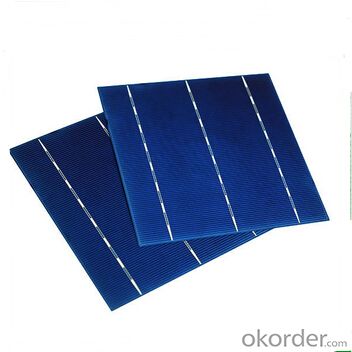
FAQ
We have organized several common questions for our clients,may help you sincerely:
①What price for each watt?
It depends on the efficiency of the solar cell, quantity, delivery date and payment terms.
②How long can we receive the product after purchase?
In the purchase of product within three working days, We will arrange the factory delivery as soon as possible. The pecific time of receiving is related to the state and position of customers.Commonly 7 to 10 working days can be served.
③Can you provide the peripheral products of the solar panels, such as the battery, controller, and inverter? If so, can you tell me how do they match each other?
Yes, we can, we have two companies for solar region, one is CNBM International, the other is CNBM engineering Co.
We can provide you not only the solar module but also the off grid solar system, we can also provide you service with on grid plant.
④What is your warranty of solar cell?
Our product can promise lower than 0.3% open box crack, we support claim after opening the box if it has crackm color difference or sth, the buyer should give pictures immediately, we can not accept the claim after the solar cell has assembled to solar panel.
• Timeliness of delivery
• ⑤How do you pack your products?
We have rich experience on how to pack the solar cell to make sure the safety on shipment, we could use wooden box or pallet as buyer's preference.
- Q: How to generate solar cells, the principle of PN junction
- Solar energy is an inexhaustible renewable energy source for human beings, and it is clean energy and does not produce any environmental pollution. In the effective use of solar energy; solar energy photoelectric utilization is the fastest growing and most dynamic in recent years
- Q: Can solar cells be used for powering amusement parks?
- Yes, solar cells can be used for powering amusement parks. Solar energy is a renewable and eco-friendly source of power that can be harnessed to meet the electricity demand of amusement parks. By installing solar panels, amusement parks can reduce their reliance on fossil fuels and contribute to a more sustainable future.
- Q: Can solar cells be used in data centers?
- Yes, solar cells can be used in data centers. Solar energy can be harnessed through the installation of solar panels, which convert sunlight into electricity. This renewable source of energy can be utilized to power various components of a data center, including servers, cooling systems, and lighting. By integrating solar cells, data centers can reduce their reliance on traditional power grids and minimize their carbon footprint.
- Q: Can solar cells be used in underwater vehicles?
- Yes, solar cells can be used in underwater vehicles. However, their efficiency may be reduced due to the limited availability of sunlight underwater.
- Q: How do solar cells perform in areas with high humidity and saltwater exposure?
- Solar cells generally perform well in areas with high humidity and saltwater exposure. While high humidity can slightly reduce the efficiency of solar cells, it does not significantly impact their overall performance. However, saltwater exposure can potentially pose a challenge as it can corrode the metal components of the solar panels over time. To mitigate this, manufacturers often use materials that are resistant to corrosion and apply protective coatings on the panels. Regular maintenance and cleaning can also help to ensure the optimal performance and longevity of solar cells in such environments.
- Q: Whether the solar cell is light can produce electricity
- A solar cell is a device that converts light energy directly into electrical energy by photoelectric effects or photochemical effects.
- Q: What is the impact of solar cell installations on property values?
- The impact of solar cell installations on property values is generally positive. Studies have shown that homes with solar panels tend to sell for higher prices and have faster selling times compared to similar homes without solar installations. Solar energy is becoming increasingly popular and homeowners recognize the financial benefits of reduced energy costs and potential tax incentives. Additionally, solar installations contribute to a more sustainable future, which is an attractive quality for many buyers.
- Q: Can solar cells be used for powering remote sensing devices?
- Yes, solar cells can be used for powering remote sensing devices. Solar cells convert sunlight into electricity, making them an ideal power source for remote sensing devices that are often located in areas without access to traditional power grids. Additionally, solar cells are renewable and environmentally friendly, making them a sustainable option for powering these devices.
- Q: Can solar cells be used in marine applications?
- Yes, solar cells can be used in marine applications. They can be installed on boats, ships, or other marine vessels to generate electricity from the sun. These solar cells can power various onboard systems and equipment, reducing the dependency on traditional fuel sources and providing a sustainable energy solution for marine applications.
- Q: Can solar cells be used in public transportation?
- Yes, solar cells can be used in public transportation. Solar panels can be installed on the roofs of buses, trains, and trams to generate electricity from sunlight. This renewable energy can be used to power various systems in public transportation, such as lighting, air conditioning, and even charging onboard devices. Additionally, solar cells can also be used to charge electric vehicles used in public transportation, reducing reliance on fossil fuels and contributing to a more sustainable transportation system.
Send your message to us
Multi Junction Polycrystalline Solar Cells Series- 16.00-17.99%
- Loading Port:
- Shanghai
- Payment Terms:
- TT OR LC
- Min Order Qty:
- 3000 pc
- Supply Capability:
- 300000 pc/month
OKorder Service Pledge
OKorder Financial Service
Similar products
Hot products
Hot Searches
Related keywords
